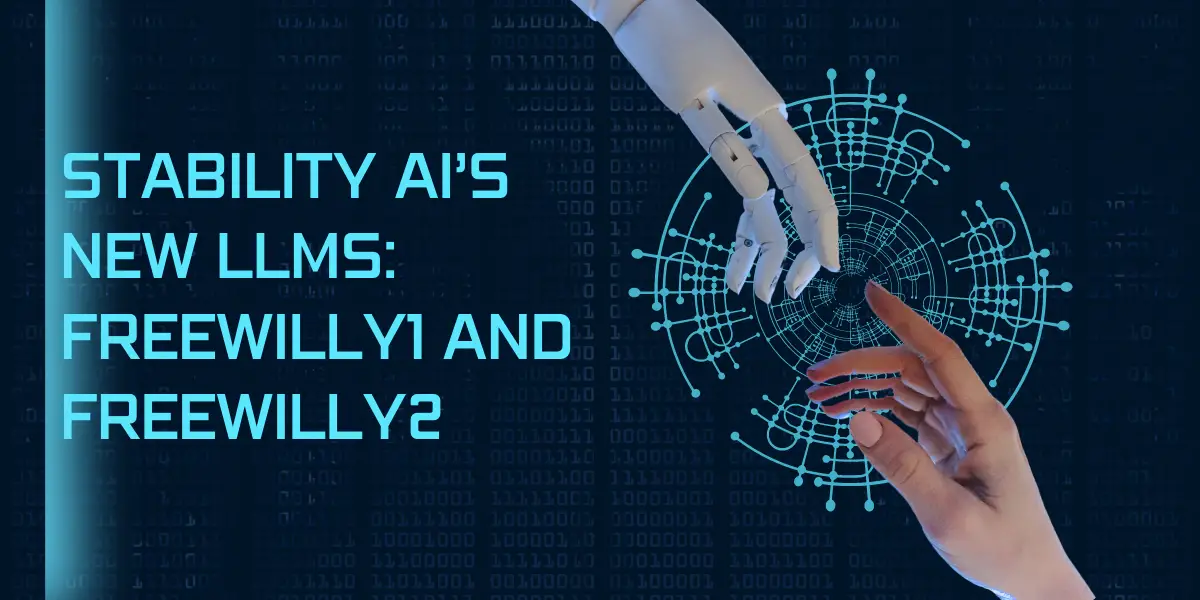What is Stability AI’s New LLMs:FreeWilly1 and FreeWilly2

In the dynamic world of Artificial Intelligence (AI), the advent of Large Language Models (LLMs) has been a game-changer. These sophisticated text-generating algorithms have initiated a computational revolution, transforming industries from translation services to creative content generation. The recent release of Stability AI’s state-of-the-art open-source LLMs, FreeWilly1 and FreeWilly2, is poised to redefine the AI landscape, pushing the boundaries of what we thought was possible.
Table of Contents
What is FreeWilly?
FreeWilly1 and FreeWilly2 are the latest offerings from Stability AI, a company renowned for its innovative AI solutions. These large language models are an evolution of Stability AI’s initial LLaMA models, bringing significant improvements in structure, accuracy, and overall performance. FreeWilly1 is based on Meta’s large-scale language model ‘LLaMA-65B’, fine-tuned on synthetically generated datasets using Supervised Fine-Tuning (SFT). FreeWilly2, on the other hand, is a more advanced model developed using ‘LLaMA 270B’. Both models are designed to analyze and respond to complex language inputs in a sophisticated and nuanced manner, making them a powerful tool for a wide range of applications.
What is Stability?
Stability AI is a trailblazer in the field of AI, known for developing advanced AI models, including the image generation AI “Stable Diffusion”. With a commitment to pushing the boundaries of AI technology, Stability AI has consistently introduced innovative solutions that have set new standards in the field. The release of FreeWilly1 and FreeWilly2 is a testament to this commitment, marking a significant milestone in the development of open-source large-scale language models.
See more:What is Stability.AI Stock and How to Buy Stability.AI Stock?
Key features of FreeWilly
- Supervised Fine-Tuning (SFT): FreeWilly models leverage the power of Supervised Fine-Tuning, a method that uses large, accurately labeled datasets to instruct the models on text generation. This approach results in highly refined outputs, making the models incredibly effective at understanding and responding to complex language inputs.
- Progressive Learning: FreeWilly models are designed to learn from their previous interactions and mistakes. This ability to learn and improve over time makes them incredibly adaptable, allowing them to handle a wide range of tasks with increasing efficiency.
- Integration of Microsoft’s Orca Approach: Stability AI has integrated Microsoft’s Orca approach into the learning process of FreeWilly models. This innovative approach, which teaches a small model the step-by-step reasoning process of a large language model, significantly enhances the models’ learning efficiency.
- Unique Approach to Synthetic Data: Synthetic data, generated internally by an AI, plays a pivotal role in the training of FreeWilly models. This approach ensures high-quality results while prioritizing data protection and privacy.
What is the difference between FreeWilly and other language models?
- Superior Performance: FreeWilly models have consistently outperformed comparable models on the market in various performance measures. Their superior performance can be attributed to their innovative training approach and the use of advanced techniques like Supervised Fine-Tuning and the Orca Method.
- Innovative Training Approach: Unlike traditional models, FreeWilly models use the ‘Orca Method’, an approach that teaches a small model the step-by-step reasoning process of a large language model. This unique approach significantly enhances the models’ learning efficiency, allowing them to generate more accurate and nuanced responses.
- Focus on Responsible Release: Stability AI places a strong emphasis on the responsible release of its models. FreeWilly models have been extensively tested for potential harm by a dedicated in-house team, ensuring that they can be used safely and responsibly.
What is the technical principle of FreeWilly?
FreeWilly models are trained using a method known as Supervised Fine-Tuning on large, accurately labeled datasets. The models are trained in mixed-precision (BF16) and optimized with AdamW, a popular optimization algorithm in the field of machine learning. The training process also incorporates the ‘Orca Method’, an approach described in Microsoft’s paper ‘Orca: Progressive Learning from Complex Explanation Traces of GPT-4’. Rather than simply mimicking the output style of a large language model, the Orca Method teaches a small model the step-by-step reasoning process of a large language model. This unique approach significantly enhances the models’ learning efficiency, allowing them to generate more accurate and nuanced responses.
What changes will the launch of FreeWilly bring?
The introduction of FreeWilly1 and FreeWilly2 is set to bring about significant changes in the AI landscape. Their ability to understand and generate sophisticated text opens up a world of possibilities for industries ranging from content creation to translation services. Furthermore, their open-source nature fosters collaboration and innovation within the AI community, paving the way for the development of new, groundbreaking applications. By providing open-source access to these advanced models, Stability AI is not only contributing to the advancement of AI technology but also democratizing access to these powerful tools.
Conclusion
The introduction of FreeWilly1 and FreeWilly2 by Stability AI marks a significant milestone in the evolution of AI technology. Their unique training methods, innovative use of synthetic data, and superior performance across various benchmarks set them apart from other models in the field. As the AI landscape continues to evolve, the role of robust models like FreeWilly1 and FreeWilly2 will undoubtedly become more prominent. Their release not only redefines our understanding of what AI technology can achieve but also sets the stage for a future where machines can understand and respond with the nuance and sophistication of a human.

